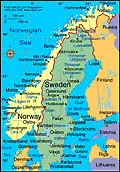Norway | Facts & Information

- Norway Profile
- History
- News and Current Events
Infoplease has everything you need to know about Norway. Check out our country profile, full of essential information about Norway's geography, history, government, economy, population, culture, religion and languages. If that's not enough, click over to our collection of world maps and flags.
Facts & Figures
-
Sovereign: King Harald V (1991)
Prime Minister: Jonas Gahr Støre (2021)
Land area: 117,483 sq mi (304,282 sq km); total area: 125,020 sq mi (323,802 sq km)
Population (2022 census): 5,553,840 (growth rate: 0.8%); birth rate: 12/1000; infant mortality rate: 2.31/1000; life expectancy: 82.55
Capital and largest city (2022 est.): Oslo, 1.071 million
Other large cities: Bergen, 270,600; Stavanger, 197,852; Trondheim, 170,242
Monetary unit: Norwegian krone
National name: Kongeriket Norge
Languages: Bokmal Norwegian (official), Nynorsk Norwegian (official), small Sami- and Finnish-speaking minorities; note - Sami has three dialects: Lule, North Sami, and South Sami; Sami is an official language in nine municipalities in Norway's three northernmost counties: Finnmark, Nordland, and Troms
Ethnicity/race: Norwegian 81.5% (includes about 60,000 Sami), other European 8.9%, other 9.6% (2021 est.)
Religions: Church of Norway (Evangelical Lutheran - official) 67.5%, Muslim 3.1%, Roman Catholic 3.1%, other Christian 3.8%, other 2.6%, unspecified 19.9% (2021 est.)
National Holiday: Constitution Day, May 17
Literacy rate: 100%
Economic summary: GDP/PPP (2020 est.): $342.06 billion; per capita $63,600. Real growth rate: 0.86%. Inflation: 2.1%. Unemployment: 3.72%. Arable land: 2.2%. Agriculture: barley, wheat, potatoes; pork, beef, veal, milk; fish. Labor force: 2.699 million; services 78.6%, industry 19.3%, agriculture, forestry, and fishing 2.1% (2020). Industries: petroleum and gas, food processing, shipbuilding, pulp and paper products, metals, chemicals, timber, mining, textiles, fishing. Natural resources: petroleum, copper, natural gas, pyrites, nickel, iron ore, zinc, lead, fish, timber, hydropower. Exports: $117.06 billion (2020 est.): petroleum and petroleum products, machinery and equipment, metals, chemicals, ships, fish. Major trading partners (exports): United Kingdom 18%, Germany 14%, Netherlands 10%, Sweden 9%, France 6%, United States 5% (2019). Imports: $119.08 billion (2020 est.): machinery and equipment, chemicals, metals, foodstuffs. Major trading partners (imports): Sweden 17%, Germany 12%, China 8%, Denmark 7%, United States 6%, United Kingdom 5%, Netherlands 5% (2019).
Communications: Telephones: main lines in use: 348,808 (2020); mobile cellular: 5,825,584 (2020). Broadcast media: state-owned public radio-TV broadcaster operates 3 nationwide TV stations, 3 nationwide radio stations, and 16 regional radio stations; roughly a dozen privately owned television stations broadcast nationally and roughly another 25 local TV stations broadcasting; nearly 75% of households have access to multi-channel cable or satellite TV; 2 privately owned radio stations broadcast nationwide and another 240 stations operate locally (2017). Internet hosts: 3.588 million (2012). Internet users: 5,218,091 (2020).
Transportation: Railways: total: 4,200 km (2019). Roadways: total: 94,902 km (includes 455 km of expressways) (2018). Waterways: 1,577 km (2010). Ports and harbors: Bergen, Haugesund, Maaloy, Mongstad, Narvik, Sture. Airports: 95 (2021).
International disputes: Norway asserts a territorial claim in Antarctica (Queen Maud Land and its continental shelf); Denmark (Greenland) and Norway have made submissions to the Commission on the Limits of the Continental shelf (CLCS) and Russia is collecting additional data to augment its 2001 CLCS submission; Norway and Russia signed a comprehensive maritime boundary agreement in 2010.









